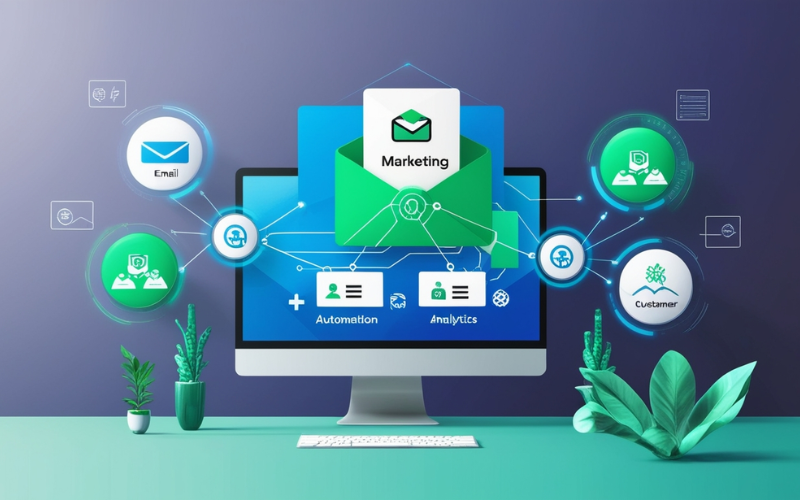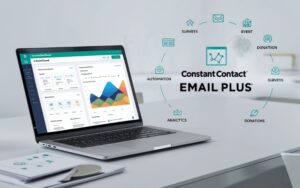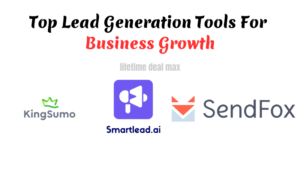Are you looking to streamline your email marketing efforts? GetResponse Workflow Automation might be the solution you need.
This tool can save you time and improve your marketing efficiency. GetResponse Workflow Automation allows you to create automated workflows for your marketing campaigns. Imagine setting up a series of emails that send automatically based on your customer’s actions. This means you can focus on other tasks while your marketing runs smoothly in the background.
Automation helps you build stronger relationships with your audience by delivering timely and relevant content. In this blog post, we will explore how GetResponse Workflow Automation works and the benefits it offers. Get ready to discover a more efficient way to manage your email marketing!

Introduction To Workflow Automation
Workflow automation is a key feature in email marketing. It saves time and ensures tasks are completed efficiently. With workflow automation, you can set up a series of actions. These actions are triggered based on user behavior or specific conditions.
What Is Getresponse?
Getresponse is an all-in-one marketing platform. It offers tools for email marketing, landing pages, and webinars. The platform is user-friendly and designed for businesses of all sizes. Getresponse includes a powerful workflow automation feature.
Importance Of Automation
Automation is crucial for any marketing strategy. It helps streamline repetitive tasks. This frees up time for more creative endeavours. Automation ensures consistency in your marketing efforts. It reduces the risk of errors.
Here are some key benefits of workflow automation:
- Time-saving: Set up once and let it run.
- Efficiency: Tasks are completed faster.
- Consistency: Standardized processes reduce errors.
- Personalization: Tailor messages based on user actions.
Workflow automation in Getresponse is easy to set up. It involves creating a series of steps. Each step is triggered by a user’s action or a specific condition.
| Feature | Description |
|---|---|
| Drag-and-Drop Builder | Simple tool to create workflows visually. |
| Pre-built Templates | Ready-made workflows for common tasks. |
| Custom Triggers | Set actions based on user behavior. |
| Analytics | Track and measure the performance of workflows. |
Getresponse’s workflow automation can improve your marketing efforts. It helps you engage with your audience more effectively.
Setting Up Your Getresponse Account
Setting up your Getresponse account is the first step to streamline your email marketing efforts. This guide will help you start using Getresponse efficiently. Follow these steps to create your account and navigate the dashboard.
Creating An Account
First, visit the Getresponse website. Click on the “Sign Up” button on the top right corner of the homepage. You’ll see a form asking for your email and password. Fill in your details and click “Create Account”.
After signing up, you’ll receive a confirmation email. Click on the link in the email to activate your account. Once activated, you’ll be directed to your new Getresponse dashboard.
Navigating The Dashboard
The dashboard is your main control centre. Here, you can manage your campaigns, contacts, and reports. The interface is user-friendly and easy to understand.
On the left side, you’ll find the main menu. The menu includes options like:
- Contacts – Manage your email lists and segments.
- Email Marketing – Create and send email campaigns.
- Automation – Set up workflows for automated emails.
- Reports – Track the performance of your campaigns.
At the top of the dashboard, there are quick-access buttons for creating new campaigns and adding contacts. Below, you’ll find widgets displaying key metrics and recent activity.
To customize your dashboard, click on the “Customize Dashboard” button. You can add or remove widgets based on your preferences. This feature helps you focus on the most relevant information.
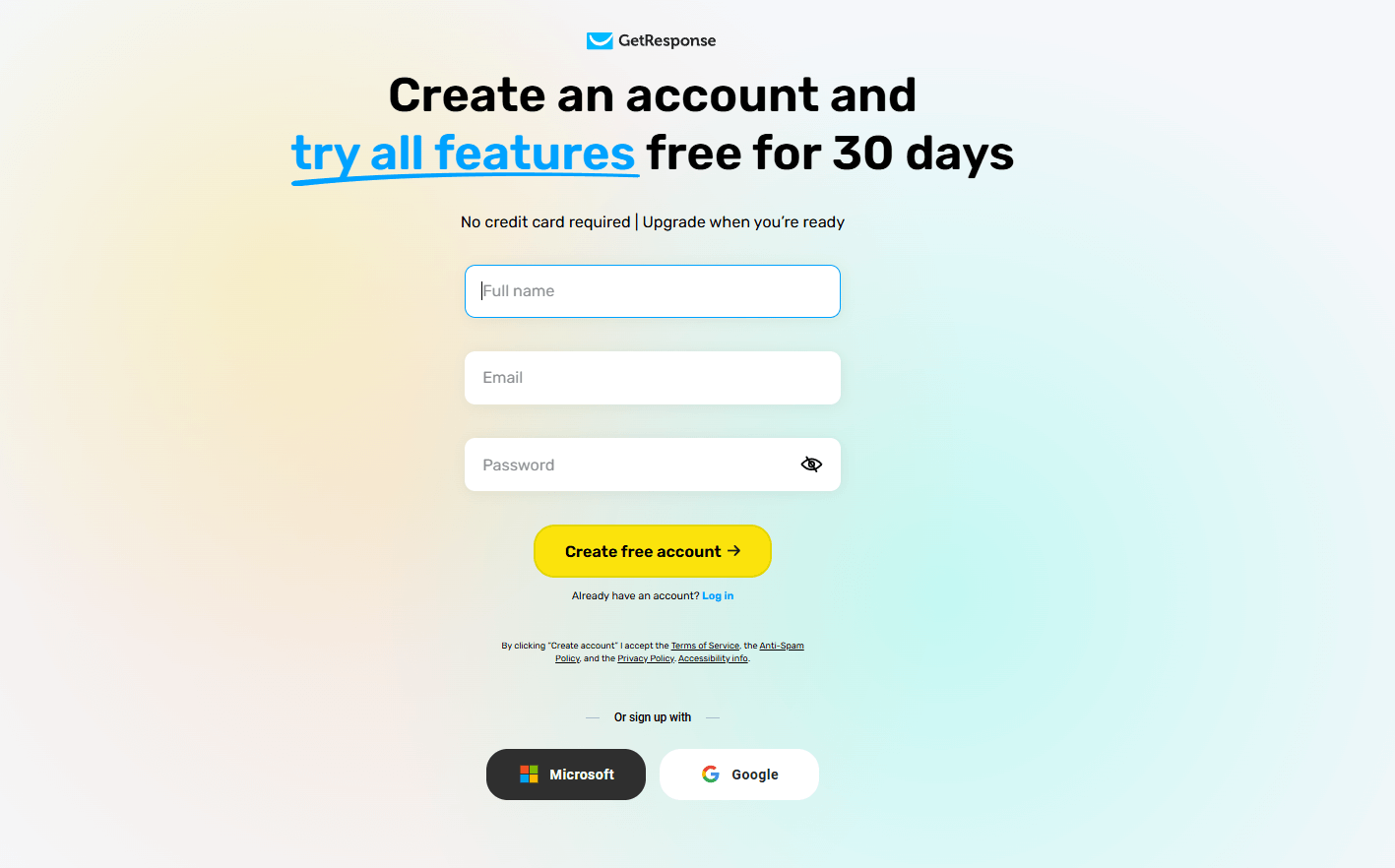
Designing Your First Workflow
Creating your first workflow in Getresponse can seem daunting. With the right approach, it becomes a simple and rewarding task. This guide helps you design your first workflow. Let’s break it down step by step.
Choosing A Template
Getresponse offers a wide range of templates for different purposes. These templates serve as the foundation for your workflow.
- Welcome Emails: Ideal for greeting new subscribers.
- Abandoned Cart: Useful for recovering lost sales.
- Lead Nurturing: Helps in guiding potential customers.
Start by selecting a template that fits your needs. This saves you time and ensures you cover all essential steps.
Customizing Your Workflow
Once you choose a template, the next step is customization. This is where you tailor the workflow to match your goals.
- Add Triggers: Define what actions will start the workflow. For example, a new subscriber joining your list.
- Set Conditions: Use conditions to create different paths. For instance, if a user opens an email, send a follow-up.
- Insert Actions: Determine what happens next. You can send emails, assign tags, or even wait for a specific time.
Each step in your workflow should lead the user towards a goal. This keeps your campaign focused and effective.
| Element | Description |
|---|---|
| Triggers | Actions that start the workflow (e.g., a new subscriber). |
| Conditions | Rules that define different paths (e.g., user opens an email). |
| Actions | Steps that follow the conditions (e.g., send an email). |
By following these steps, you can build a workflow that is both effective and easy to manage. Remember, the key is to keep the user engaged and guide them towards a specific goal.
Explore top email marketing tools to boost your campaigns, Top Email Marketing Tools
Segmentation And Targeting
Segmentation and targeting are essential components of effective email marketing campaigns. By segmenting your audience, you can send personalized messages that cater to specific groups. This approach increases engagement and conversion rates. Getresponse Workflow Automation helps streamline this process, making it easier to create and manage segments.
Creating Segments
Creating segments in Getresponse is straightforward. You can divide your audience based on various criteria. These criteria include:
- Demographics: Age, gender, location
- Behaviour: Purchase history, email opens, clicks
- Preferences: Interests, preferences
Start by navigating to the segmentation tool. Choose your criteria from the available options. This step allows you to create targeted segments. The tool’s user-friendly interface simplifies the process.
Personalizing Messages
Personalizing messages is key to effective email marketing. Getresponse Workflow Automation offers various features to help with this. Use merge tags to personalize emails. For example, include the recipient’s first name in the email.
Additionally, tailor your content based on segment criteria. For instance, send product recommendations based on past purchases. This method makes your emails more relevant to the recipients.
Here is a simple example of using merge tags:
Dear [FirstName],In this example, [FirstName] will be replaced with the recipient’s actual first name. This small touch can make a big difference.
Personalized messages improve open rates and engagement. They make your audience feel valued and understood. Getresponse Workflow Automation makes it easy to implement these personalized touches in your emails.
Automation Triggers And Actions
Automation triggers and actions are the core components of Getresponse Workflow Automation. They allow users to create efficient, personalized communication flows. This section will explore how to define triggers and set up actions to streamline your email marketing efforts.
Defining Triggers
Triggers are events that start a workflow. They can be based on user behaviour or specific dates. Here are some common triggers:
- Email Opened: Start a workflow when a user opens an email.
- Link Clicked: Trigger actions when a link in an email is clicked.
- Subscription Date: Start a sequence based on the subscription date.
- Tag Added: Begin actions when a tag is applied to a contact.
Setting Up Actions
Actions are tasks that occur after a trigger is activated. These tasks help in guiding the user through a personalized journey. Common actions include:
- Send Email: Automatically send an email to the user.
- Wait: Pause the workflow for a specified time.
- Add Tag: Tag the user for segmentation purposes.
- Move to List: Move the user to a different list.
Below is a table summarizing common triggers and actions:
| Trigger | Action |
|---|---|
| Email Opened | Send Follow-up Email |
| Link Clicked | Add Tag |
| Subscription Date | Send Welcome Email |
| Tag Added | Move to VIP List |
By carefully defining triggers and setting up actions, you can create dynamic workflows. These workflows will enhance user engagement and improve campaign efficiency.
Analyzing And Optimizing Workflows
Analyzing and optimizing workflows in GetResponse is crucial for improving efficiency. By examining and refining your workflows, you can enhance performance and achieve better results. Let’s dive into the key aspects of analyzing and optimizing workflows.
Tracking Performance
Tracking performance is essential for understanding how your workflows perform. GetResponse provides various tools to help monitor your workflows. Key metrics include:
- Open Rates: Percentage of emails opened by recipients.
- Click-Through Rates: Percentage of recipients who clicked on links.
- Conversion Rates: Percentage of recipients who completed a desired action.
Use these metrics to identify strong and weak points in your workflows. Regular tracking helps you stay on top of your campaign’s health and effectiveness.
Making Data-driven Adjustments
Making data-driven adjustments is vital for optimizing your workflows. Here’s how to do it:
- Analyze Data: Review the performance metrics regularly.
- Identify Patterns: Look for patterns and trends in the data.
- Test Changes: Implement changes based on your findings.
- Measure Impact: Track the impact of these changes.
For example, if open rates are low, test different subject lines. If click-through rates are poor, try more engaging content. Always measure the results of your changes to ensure you are moving in the right direction.
Utilize the insights from your data to continuously refine and improve your workflows.
Integrating With Other Tools
Integrating Getresponse Workflow Automation with other tools can significantly enhance your marketing efforts. By connecting different systems and apps, you streamline your processes and ensure seamless data flow. This integration allows you to manage your campaigns more effectively and efficiently.
Connecting CRM Systems
Connecting Getresponse with your CRM system is crucial for maintaining a centralized customer database. With this integration, you can sync customer data between platforms. This ensures that your contact lists are always up-to-date.
Here are some benefits of integrating with CRM systems:
- Centralized customer information
- Improved data accuracy
- Enhanced customer segmentation
Popular CRM systems that integrate with Getresponse include Salesforce, HubSpot, and Zoho CRM. These integrations enable you to better understand your customers and tailor your marketing efforts accordingly.
Using Third-party Apps
Getresponse Workflow Automation also supports integration with various third-party apps. These apps help expand the functionality of your marketing campaigns. By using third-party apps, you can automate tasks, track performance, and improve engagement.
Common third-party apps used with Getresponse include:
| App | Purpose |
|---|---|
| Zapier | Automate repetitive tasks |
| Google Analytics | Track campaign performance |
| Shopify | Manage e-commerce activities |
Integrating these apps with Getresponse allows you to create a more efficient marketing ecosystem. Automation becomes simpler, and your marketing strategies become more effective.
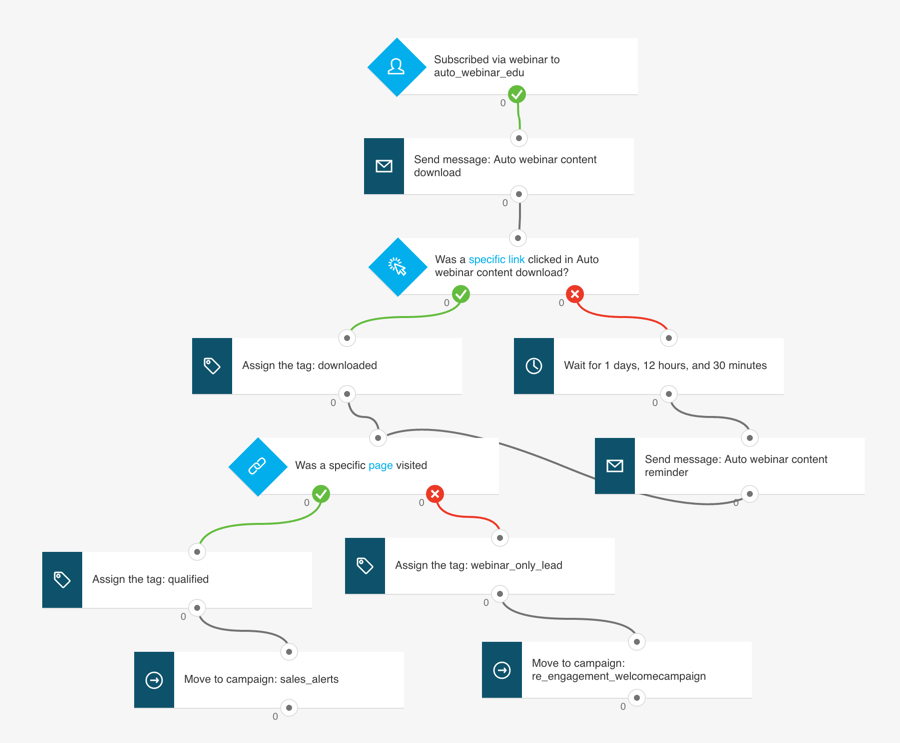
Common Workflow Automation Mistakes
Getresponse Workflow Automation offers powerful tools to streamline your email marketing. However, common mistakes can reduce its effectiveness. Here are some critical errors to avoid.
Avoiding Over-automation
One of the biggest mistakes is over-automation. Automating every single task can lead to impersonal communication. It’s essential to maintain a human touch in your interactions.
Here are some tips to avoid over-automation:
- Automate repetitive tasks only.
- Personalize messages wherever possible.
- Monitor automated workflows regularly.
Over-automation can alienate your audience. They may feel like they are only talking to machines. Balance automation with personal engagement to build strong relationships.
Testing And Iteration
Another common mistake is neglecting testing and iteration. Workflow automation is not a set-it-and-forget-it solution. Regular testing ensures your workflows function correctly.
Consider these steps for effective testing:
- Run tests before fully deploying workflows.
- Gather feedback from your audience.
- Make data-driven adjustments.
Iteration is key. Based on feedback and data, refine and improve your workflows. This helps in maintaining effectiveness and relevance.
Here’s a simple table to summarize these points:
| Common Mistake | Solution |
|---|---|
| Over-Automation | Automate only repetitive tasks and personalize communications. |
| Lack of Testing | Run tests and gather feedback regularly. |
Avoid these common mistakes to maximize the benefits of Getresponse Workflow Automation.
Case Studies And Success Stories
Getresponse Workflow Automation has transformed businesses across various industries. The following case studies and success stories illustrate the impact of automation on both small businesses and large enterprises. These real-life examples highlight the power of workflow automation in streamlining processes and driving growth.
Check out real user reviews of Zoho CRM and see how it can help your business, Zoho CRM Reviews from Real Users
Small Business Success
Many small businesses have leveraged Getresponse Workflow Automation to enhance their operations. Here are a few notable examples:
- Local Bakery: A local bakery used Getresponse to automate their email marketing campaigns. They saw a 30% increase in customer engagement.
- Online Boutique: An online boutique streamlined their order processing. They reduced manual errors and improved customer satisfaction.
- Fitness Studio: A fitness studio automated their class schedules and reminders. This led to higher attendance rates and more repeat customers.
These small businesses achieved significant results with minimal effort. The automation tools provided by Getresponse made their processes more efficient and effective.
Enterprise-level Automation
Large enterprises also benefit from Getresponse Workflow Automation. Here are some success stories:
| Company | Industry | Results |
|---|---|---|
| Global Retailer | Retail | Increased sales by 25% through personalized email campaigns |
| Tech Firm | Technology | Improved lead conversion rates by 40% with automated follow-ups |
| Financial Services | Finance | Reduced customer churn by 15% through targeted retention strategies |
These enterprises harnessed the power of automation to achieve their goals. Getresponse Workflow Automation provided them with the tools to automate complex processes, resulting in measurable success.

Future Trends In Marketing Automation
The world of marketing automation is constantly evolving. New trends are shaping the way businesses connect with their audience. Getresponse Workflow Automation is at the forefront of these changes. Let’s explore some of the future trends.
AI and Machine Learning
Artificial Intelligence (AI) and Machine Learning (ML) are transforming marketing automation. These technologies allow for better data analysis. They help to predict customer behaviour. This leads to more personalized marketing strategies.
AI can analyze large amounts of data quickly. It identifies patterns and trends that humans might miss. ML algorithms learn from this data. They improve over time, becoming more accurate. This creates a more efficient marketing process.
For example, AI can segment your audience. It can create customized messages for each segment. This increases engagement and conversion rates. ML can also optimize email send times. It ensures your messages reach your audience at the right time.
Customer Experience Focus
Customer experience is becoming a key focus in marketing automation. It’s not just about sending messages. It’s about creating meaningful interactions with customers. Getresponse Workflow Automation helps to achieve this.
Personalization is a big part of improving customer experience. Customers expect relevant content. They want offers that match their interests. Automation tools can help deliver this. They use data to understand customer preferences. They tailor messages to meet these needs.
Another trend is omnichannel marketing. Customers interact with brands across multiple channels. They use email, social media, and websites. Workflow automation ensures a seamless experience across all these channels. It provides consistent messaging, regardless of the platform.
By focusing on customer experience, businesses can build stronger relationships. They can increase customer loyalty and retention. This is crucial for long-term success.
| Trend | Benefit |
|---|---|
| AI and Machine Learning | Improved data analysis and customer segmentation |
| Customer Experience Focus | Enhanced personalization and omnichannel marketing |
Frequently Asked Questions
What Is Getresponse Workflow Automation?
Getresponse workflow automation helps automate email marketing tasks. It streamlines customer interactions, boosts engagement, and saves time.
How Does Getresponse Automation Work?
Getresponse automation uses triggers, conditions, and actions. It sends emails based on user behavior. This ensures timely and relevant communication.
Can I Customize Workflows In Getresponse?
Yes, Getresponse offers customizable workflows. You can tailor them to fit your specific marketing needs and goals.
Is Getresponse Automation Suitable For Beginners?
Yes, Getresponse automation is user-friendly. It has an intuitive interface and provides templates for easy setup.
Conclusion
Getresponse Workflow Automation simplifies your email marketing tasks. It helps save time and reduces errors. You can easily create customized workflows. Boost engagement and sales with automated emails. It’s an efficient way to manage your campaigns. Start using it to streamline your marketing efforts.
Enjoy the benefits of automation without the stress. Try it today and see the difference. Automate your workflow for better results.

